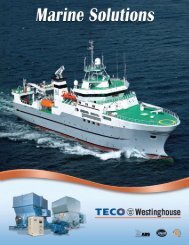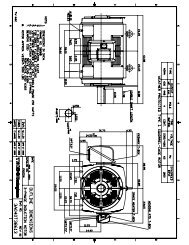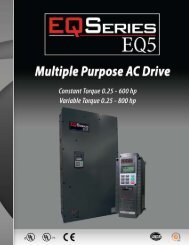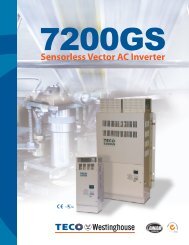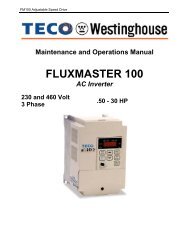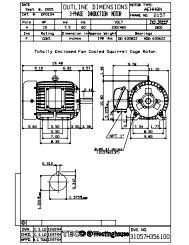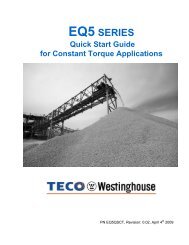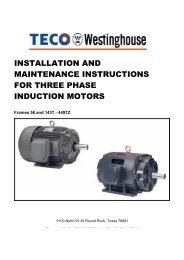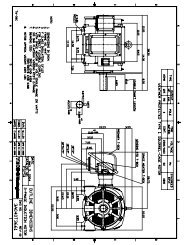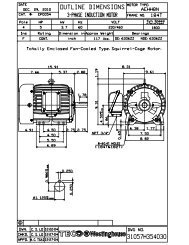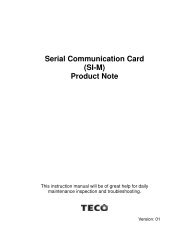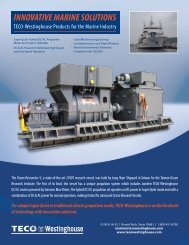EQ7 Series Instruction Manual - TECO-Westinghouse Motor Company
EQ7 Series Instruction Manual - TECO-Westinghouse Motor Company
EQ7 Series Instruction Manual - TECO-Westinghouse Motor Company
You also want an ePaper? Increase the reach of your titles
YUMPU automatically turns print PDFs into web optimized ePapers that Google loves.
1.2 Installation and wiring practices<br />
Mounting of the <strong>EQ7</strong> drive is extremely important for accessibility as well as for the environment. Various <strong>EQ7</strong> drive<br />
models are available and the mounting dimensions (footprint) may be different. Install the <strong>EQ7</strong> drive in an<br />
environment that satisfies the requirements.<br />
<strong>TECO</strong>-<strong>Westinghouse</strong> <strong>Motor</strong> <strong>Company</strong> strongly recommends installing inverters in a panel for safety reasons, in<br />
particular, when installing the ones that have an enclosure rating of IP00.<br />
When installing the <strong>EQ7</strong> drive in a place out of the specified environmental requirements, it is necessary to derate the<br />
inverter or consider the panel engineering design suitable for the special environment or the panel installation<br />
location. For details consult your <strong>TECO</strong>-<strong>Westinghouse</strong> <strong>Motor</strong> <strong>Company</strong> representative. The special environments<br />
listed below require using the specially designed panel or considering the panel installation location.<br />
• Installation environment<br />
Environments Possible problems Sample measures Applications<br />
Highly concentrated<br />
sulfurizing gas or<br />
other corrosive gases<br />
A lot of conductive<br />
dust or foreign<br />
material (e.g., metal<br />
powders or shavings,<br />
carbon fibers, or<br />
carbon dust)<br />
A lot of fibrous or<br />
paper dust<br />
High humidity or dew<br />
condensation<br />
Vibration or shock<br />
exceeding the<br />
specified level<br />
Fumigation for export<br />
packaging<br />
Corrosive gases cause parts<br />
inside the inverter to corrode,<br />
resulting in an inverter<br />
malfunction.<br />
Entry of conductive dust into<br />
the inverter causes a short<br />
circuit.<br />
Fibrous or paper dust<br />
accumulated on the heat sink<br />
lowers the cooing effect.<br />
Entry of dust into the inverter<br />
causes the electronic circuitry<br />
to malfunction.<br />
In an environment where a<br />
humidifier is used or where the<br />
air conditioner is not equipped<br />
with a dehumidifier, high<br />
humidity or dew condensation<br />
results, which causes a shortcircuiting<br />
or malfunction of<br />
electronic circuitry inside the<br />
inverter.<br />
If a large vibration or shock<br />
exceeding the specified level is<br />
applied to the inverter, for<br />
example, due to a carrier<br />
running on seam joints of rails<br />
or blasting at a construction<br />
site, the inverter structure gets<br />
damaged.<br />
Halogen compounds such as<br />
methyl bromide used in<br />
fumigation corrodes some<br />
parts inside the inverter.<br />
Any of the following measures may be<br />
necessary.<br />
-Mount the inverter in a sealed panel<br />
with IP6X or air-purge mechanism.<br />
-Place the panel in a room free from<br />
influence of the gases.<br />
Any of the following measures may be<br />
necessary.<br />
-Mount the inverter in a sealed panel.<br />
-Place the panel in a room free from<br />
influence of the conductive dust.<br />
Any of the following measures may be<br />
necessary.<br />
-Mount the inverter in a sealed panel<br />
that shuts out dust.<br />
-Ensure a maintenance space for<br />
periodical cleaning of the heat sink in<br />
panel engineering design.<br />
-Employ external cooling when<br />
mounting the inverter in a panel for<br />
easy maintenance and perform<br />
periodical maintenance.<br />
- Put a heating module such<br />
as a space heater in the panel.<br />
-Insert shock-absorbing materials<br />
between the mounting base of the<br />
inverter and the panel for safe<br />
mounting.<br />
-When exporting an inverter built in a<br />
panel or equipment, pack them in a<br />
previously fumigated wooden crate.<br />
-When packing an inverter alone for<br />
export, use a laminated veneer lumber<br />
(LVL).<br />
Table 1.2: Installation environment<br />
Paper manufacturing, sewage<br />
disposal, sludge treatment,<br />
tire manufacturing, gypsum<br />
manufacturing, metal<br />
processing, and a particular<br />
process in textile factories.<br />
Wiredrawing machines, metal<br />
processing, extruding<br />
machines, printing presses,<br />
combustors, and industrial<br />
waste treatment.<br />
Textile manufacturing and<br />
paper manufacturing.<br />
Outdoor installation.<br />
Film manufacturing line,<br />
pumps and food processing.<br />
Installation of an inverter<br />
panel on a carrier or selfpropelled<br />
machine.<br />
Ventilating fan at a<br />
construction site or a press<br />
machine.<br />
Exporting.<br />
1-3



